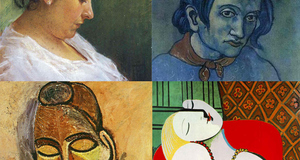"It's a Wise Child:" A Levinasian Analysis of J. D. Salinger's Glass Family Stories
By
2016, Vol. 8 No. 11 | pg. 3/3 | « V. Conceptualizing the Other as God and the Fat Lady“Faith is not a question of the existence or non-existence of God. It is believing that love without reward is valuable.” – Levinas From the very beginning of the novella Zooey, where Buddy as the narrator insists that the story that follows isn’t a mystical story but a love story, to the very ending, where Franny finds peace in the idea of performing her role in society for the Fat Lady, there is an emphasis on the concept of God as the Other. The Fat Lady is Seymour’s abstract conception of the Other, one which both Zooey and Franny have mentally fleshed out in greater detail to help them visualize when carrying out the tasks of everyday life. Seymour uses the Fat Lady as a rationale to tell young Zooey and Franny to be the best version of themselves for their appearances on the radio show “It’s A Wise Child.” They imagine her to be a very old woman with cancer, sitting in the heat with the radio going full blast, and suddenly, Seymour’s injunctions to shine one’s shoes for the Fat Lady, or to be funny for the Fat Lady, make sense. Zooey reminds Franny of this construct of Seymour’s, and in addition, tells her that, “There isn’t anyone out there who isn’t Seymour’s Fat Lady… don’t you know who that Fat Lady really is?... It’s Christ himself. Christ Himself, buddy” (Salinger, 1961/2010, p. 131). In this last revelation, Franny finds peace and a release from her existential crisis. There is something distinctly Levinasian about this, in the way that Franny’s being in the world is now justified by her service to the Other, in making the world a little more bearable for the Fat Lady through her cleverness on the quiz show or her acting in summer stock theater. Zooey tells her, “The only thing you can do now, the only religious thing you can do, is act. Act for God, if you want to – be God’s actress, if you want to. What could be prettier?” (Salinger, 1961/2010, p. 129), thus equating the Fat Lady, the Other, to God. Levinas similarly theorizes God within a person’s relationship with the Other. According to theologist Ryan Urbano (2012), “Levinas claims that God is glimpsed in the ethical experience… He believes that God is revealed as a trace through the face of the Other to whom the self is called to serve and love” (p. 50). In serving the Other, one finds the sacred. The self, being always subject to the Other, defines this ethical relation as something other than human nature, or as Levinas says, “The ethical situation is a human situation, beyond human nature, in which the idea of God comes to mind” (Kearney, 1986). Levinas defines his ethics as beyond human nature because it defies nature’s mandate of survival of the fittest, or to always put oneself and one’s own survival first. In this conception of ethics, God is also against nature, in his existence within the part of ourselves that goes against nature, the part that is subject to the Other.Subjection and service to the Other is also emphasized as the best way to worship or to live a religious life. Seymour’s exhortations to do one’s best for the Fat Lady and Zooey’s equation of the Fat Lady to Christ point to a religious and ethical preoccupation with the Biblical injunction to love your neighbor. To borrow a phrase form Zooey, however, this idea in the Glass family is “strictly non-sectarian” (Salinger, 1961/2010, p.62). In Seymour’s diary, he writes of studying Hindu Vedanta scriptures just before his wedding, which illustrate the same idea: “Marriage partners are to serve each other. Elevate, help, teach, strengthen each other, but above all, serve. Raise their children honorably, lovingly, and with detachment. A child is a guest in the house, to be loved and respected – never possessed, since he belongs to God” (Salinger, 1961/2010, p. 91). The emphasis on love and service to the Other being equal to religious devotion is repeated throughout the stories. The equation of love and religion is most often demonstrated through a focus on seemingly mundane, everyday acts of love. Zooey criticizes Franny’s conception of religion when she consistently refuses the chicken soup that Bessie keeps offering her out of concern for her health. “How in hell are you going to recognize a legitimate holy man when you see one if you don't even know a cup of consecrated chicken soup when it's right in front of your nose?” (Salinger, 1961/2010, p.128). In opposition to Franny, Seymour is often described as delighting in relatively insignificant things: My brother, for the record, had a distracting habit, most of his adult life, of investigating loaded ashtrays with his index finger, clearing all the cigarette ends to the sides – smiling from ear to ear as he did it – as if he expected to see Christ himself curled up cherubically in the middle, and he never looked disappointed (Salinger, 1963/1991, p. 108). In addition, Seymour is often described as the kindest and most loving of all of Bessie’s sons. He consistently displays a reverence for the Other in small, everyday interactions. He is described as having a funny-looking appearance, but “he cared alternately much and not at all about his funny-lookingness. When he cared much, he cared for the sake of other people” (Salinger, 1963/1991, p. 180). In this sense, Seymour is the only member of the Glass family whose self-effacing nature makes him an adept at relating to the Other ethically. The contrast between Seymour’s and Buddy’s approaches to poetry and fiction writing in relation to each one of them serving the Other is significant. Unlike Buddy, Seymour is described as being uncomfortable with publication of his poetry because he felt it would be “faintly affronting” to publish poetry written in an Eastern style to a Western audience, and that he would come off as an ingrate, as “someone who was turning his back…on his own environment and the people in it who were close to him” (Salinger, 1963/1991, p. 124). Seymour visualized the librarian in the public library he used to frequent as a child as the audience to his poetry and said that “it was no joy to him to finish writing a poem and know that Miss Overman would have trouble turning to it with pleasure or involvement” (Salinger, 1963/1991, p. 125). Miss Overman is another incarnation of Seymour’s Fat Lady, an Other to whom he is subject. Seymour cannot publish for fear that doing so will upset his own subjectivity and force his own ideas upon the world, ideas of which both the content and format might not appeal to his readers. In contrast, Buddy describes himself as having “never written a line longhand in my life without instantly visualizing it in eleven-point type” (Salinger, 1963/1991, p. 124). Throughout Seymour – An Introduction, Buddy as the narrator writes several self-indulgent asides and digressive rants into the text, acknowledging that this is imposing upon his audience, but continuing with the practice anyway: Shrill, unpleasant voice (not any of my readers): …We don’t want all this goddamn analysis and gluey stuff. But I do. I want every bit of the gluey stuff (Salinger, 1963/1991, p. 170).
Buddy’s defined ownership of his medium, his insistence upon writing whatever he wants to, regardless of how the reader will respond, is in stark contrast to Seymour’s subjectivity. It mirrors Zooey’s continued rant against Franny’s behavior and subsequent lecture in Franny and Zooey despite her desperate attempts to head him off and his cognizance of her clearly very upset state. These actions show a failure on Buddy’s and Zooey’s parts to serve the Other, something that Seymour never shows. Buddy even acknowledges that if their positions were switched and Seymour were the one writing about him, “he would be so affected – so stricken, in fact – by his gross seniority as narrator and official shot-caller that he would abandon this project” (Salinger, 1963/1991, p. 170). Buddy hints at his and Zooey’s failures to be as kind as Seymour in his letter, when he says, “Be kinder to Bessie, Zooey, when you can. I don’t think I mean because she’s our mother, but because she’s weary” (Salinger, 1961/2010, p. 39). Here, Buddy makes the point that consistent, detached altruistic love trumps emotional, personal love, and that love for the Other is more important than love for any particular other. The younger siblings in the family have not yet cultivated the detachment necessary to steadily view everyone with the same love and respect that they have for their siblings, although they recognize that that is the path to a truly religious life, and to a life lived with wisdom. In conclusion, the ethics of Salinger’s wise children are without a doubt strikingly similar to Levinasian ethics, despite the fact that the Glass family works were published long before Levinas published his Ethics as First Philosophy. The Glass family stories, examined through the Levinasian construct of the ethical responsibility to the Other, invite the reader to examine his or her own code of ethics and include the ethical within their definition of wisdom. ReferencesBeavers, A. F. (1995). Introducing Levinas to Undergraduate Philosophers. http://faculty.evansville.edu/tb2/PDFs/UndergradPhil.pdf (May 8, 2016). Belletto, S. (2011). Digression, Ethical Work, and Salinger’s Postmodern Turn. Literature Interpretation Theory, 22: 4-24. DOI: 10.1080/10436928.2011.546769 Grant, B. (2002). Looking Through the Glasses: Salinger’s Wise Children and Gifted Education. Gifted Child Quarterly 46.1: 6-14. http://www.positivedisintegration.com/Grant2002.pdf Kearney, R. (1986). Face to Face with Levinas. Albany, NY: State University of New York Press. Leitch, V. B. (2010).The Norton Anthology of Theory and Criticism. New York, NY: W.W. Norton & Co. Levinas, E. (1989). The Levinas Reader. S. Hand (Ed.). Oxford: Basil Blackwell Ltd. Levinas, E. (1979). Totality and Infinity: An Essay on Exteriority. A. Lingis (Ed.). The Hague: Martinus Nijhoff Publishers. Lindahl, E. M. (2002). Face to Face. Pietisten XVII.1: 1. http://www.pietisten.org/summer02/facetoface.html Salinger, J. D. (2010). For Esme – With Love and Squalor. London: Penguin Books. (Original work published 1953) Salinger, J.D. (2010). Franny and Zooey. London: Penguin Books. (Original work published 1961) Salinger, J.D. (1965). Hapworth 16, 1924. The New Yorker XLI: 32-113. http://www.newyorker.com/magazine/1965/06/19/hapworth-16-1924 Salinger, J. D. (1991). Raise High the Roof Beam, Carpenters and Seymour: An Introduction. New York: Little, Brown and Company. (Original workpublished 1963) Urbano, R. (2012). Approaching the Divine: Levinas on God, Religion, Idolatry, and Atheism. Logos: A Journal of Catholic Thought and Culture 15.1: 50-81. DOI: 10.1353/log.2012.0003 Endnotes1.) The Other in Levinas’ work is the abstract idea of another being, to which the self is always subject. In this paper, I will be using the lowercase “other” to indicate the actual person which the self encounters in daily life. Suggested Reading from Inquiries Journal
Inquiries Journal provides undergraduate and graduate students around the world a platform for the wide dissemination of academic work over a range of core disciplines. Representing the work of students from hundreds of institutions around the globe, Inquiries Journal's large database of academic articles is completely free. Learn more | Blog | Submit Latest in Literature |


















